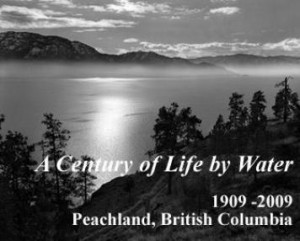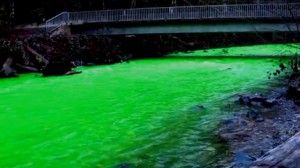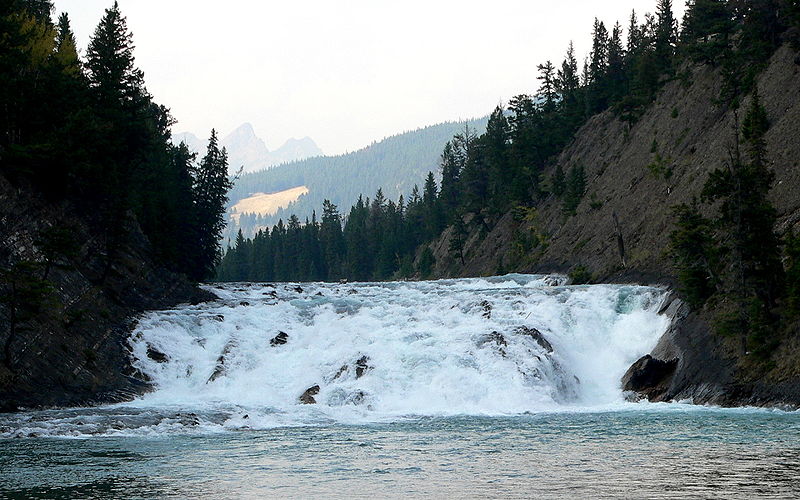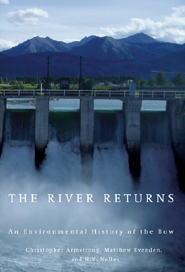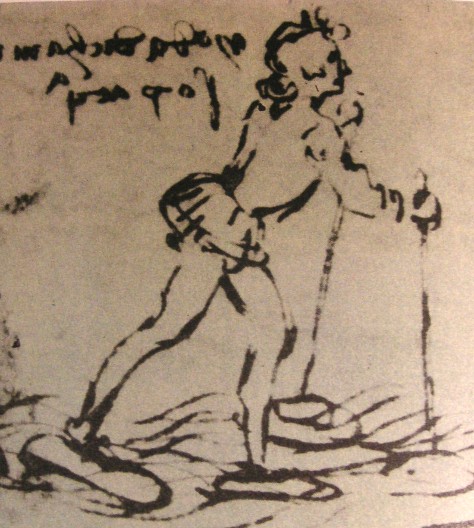Readers of BC Studies will have seen the recent issue on the Okanagan which contained several essays on water and sustainability themes. This led me to a virtual museum of Canada exhibit, developed by the Peachland Historical Society, dealing with “A Century of Life by Water”. Comprised primarily of historical photographs, the exhibit invites visitors to examine how settlers in a relatively dry environment drew from, interacted with and traveled on water. Some maps and narratives provide context.
Author Archives: mevenden
Greenstream, Goldstream
Goldstream, located on Vancouver Island, ran neon green yesterday. Someone added a flourescent dye to the water. The popular salmon stream, running through a provincial park, became as a result the focus of a small media frenzy (with 75 news sources carrying the story online). According to CTV a smiliar incident occurred last summer on the Salmo River in interior British Columbia. Is the dye non-toxic? What motivated this neon statement? Is this performance art? Compare the photo of Goldstream below to Edward Bu rtynsky’s Nickel Tailings #34.
rtynsky’s Nickel Tailings #34.
EH+ conference announced
EH+
Writing the Next Chapter of Canadian Environmental History
NiCHE and the Wilson Institute for Canadian History are hosting “EH+”,
a symposium to evaluate the field of Canadian environmental history
thus far, identify future directions with potential national and
international significance, and facilitate collaboration. The 29-30
April and 1 May 2011 event will consist of 50 participants: graduate
students, junior and senior scholars, as well as governmental and
public history partners. The event is open to historians and
historical geographers studying Canadian environmental history and
those studying other regions in the world at Canadian Universities.
NiCHE and the Wilson Institute will pay travel and subsistence costs.
The symposium will also have a simultaneous online component, allowing
those unable to attend to participate. For more information see the
event website: http://niche-canada.org/ehplus
Water History in South Africa
The International Water History Association has recently circulated a call for papers for a meeting in South Africa to be held 5-7 July, 2011. The conference will be held in Kruger National Park.
Summer reading
As the fall approaches, I thought I’d remind everyone that it isn’t too late for summer reading! One book I’ve been enjoying is Christina Palassio and Wayne Reeves’ edited collection, HTO: Toronto’s Water from Lake Iroquois to Lost Rivers to Low-flow Toilets published by Coach House Press. Each of the chapters is short, informative and interesting; the writing is clever and punchy and there are interesting illustrations. The book bridges recent academic research and that by a host of local experts who have followed water issues in Toronto closely. Maybe this book might serve as a model for other cities and other issues?
HTO

Podcast
Banff Park Radio has posted a podcast of an interview I did with Allan Buckingham in the Alpine Author’s series on the River Returns. Search through their site and you’ll discover a range of interesting material, including ten episodes on water, Streams of Thought.
Bow Falls, Banff National Park//Photo by Ken Thomas, wikimedia commons
Site C (again)
On April 19, 2010, Premier Gordon Campbell announced his government’s intention to proceed with the development of Site C on the Peace River. Most of the press coverage I have read has focused on the staging of the announcement (which invoked the historical legacy of W.A.C. Bennett), but has paid little attention to the more complex historical background of Site C, or why some groups might be concerned or opposed. For some hint of that background, have a look at a forum of op-eds (pro and con) that I edited for BC Studies last year. The following is part of my introduction that provides some historical context:
Site C forum: Considering the prospect of another dam on the Peace River
Site C marks a place on the Peace River, 7 km southwest of Fort St. John. The name has no connection to First Nations history, settler narratives, national or imperial history. It was invented in the 1950s by surveyors seeking to locate dam sites on the Peace River. Between Hudson’s Hope and the Alberta border, five such sites were located, each bearing a different letter, A, B, C, D and E. Site C was simply a surveyor’s place marker, conveying a modern understanding of territory and development. The letters had no local significance beyond that.
For the next twenty years, Site C remained an abstract signifier better known on maps than on the ground. The Wenner-Gren Corporation, which conducted the initial surveys, abandoned plans to dam the Peace. When the province assumed the task in the 1960s as part of a broader hydro-electric development strategy encompassing the Peace and Columbia rivers, it focused on developing upstream sites, impounding the headwaters at Lake Williston and passing the regulated flow through another dam completed in 1980 in the Peace Canyon. Over a few of years, a vast northern river was reconstructed. Lake Williston flooded a huge territory to form the largest human-made lake in North America. The regulated flow altered the seasonal rhythms of the river, bearing consequences for the river and ecology downstream, as far as the Peace-Athabasca delta.
In the late 1970s, Site C became the focus of a major debate about the future of hydro-electricity in British Columbia. BC Hydro, the provincial utility, wished to fulfill the logic of the Peace River projects and develop the next dam at Site C. Local interests reacted negatively. Earlier projects had caused considerable dislocation and hardship in the Peace Valley, particularly for First Nations, and another dam seemed too much to bear. A local environmental group, the Peace Valley Environment Association, formed in opposition. In 1982, the Site C project failed to gain the necessary energy project certificate from the newly formed BC Utilities Commission. The reason was not the potential environmental or social impacts, but because the BCUC judged that BC Hydro’s demand forecasts were unreliable and that other alternatives had not been sufficiently explored. In some ways the battle over Site C highlighted the controversial legacy of British Columbia’s big dam era, underlined the new role of environmentalism in large infrastructure planning and raised the possibility that future developments should be imagined and handled differently. These points were reinforced in the early 1990s when BC Hydro launched contingency investigations for a dam at Site C in the face of rising provincial demand. In the end, the corporation opted to pursue more aggressive conservation strategies and develop gas-fired generation.
Twenty years later and the name Site C has taken on a new significance. Site C once reflected a modernist view of progress; now its bears associations with clean energy in the Kyoto era. It sits at the center of the BC government’s Energy Plan which aims to reduce dependence on imported electricity and to find new sources of emissions-free generation to meet the rising electricity demands of the province. BC Hydro has been instructed to investigate the possibility of a dam at Site C and to consult the public. Over two years, public meetings have been held about Site C, new opposition coalitions have formed, and sundry investigations have been launched.
water history and water management
I receive a lot of textbooks in the mail. If you teach a first year geography class, as I do, publishers will hope to convince you that their textbook is the one for your students. There is a lot of money to be made. I don’t use a textbook, but I do look at the many on offer. One that has recently crossed my desk deserves mention for its unusual inclusion of an historical perspective in a work dealing primarily with water management, Thomas V. Cech’s Principles of Water Resources. This is not simply policy history. Cech actually spends two pages explaining the historical development of the qanat system in the Middle East. Have a look!
The River Returns
McGill-Queen’s Press has kindly provided a discount form for my latest book, co-authored with Christopher Armstrong and H.V. Nelles, The River Returns: An Environmental History of the Bow
Here is the hyper-link:river-returns-discount-flyer
Happy Reading!
Walking on water
And now for something completely different… An article by Paul Collins in the 03 January 2010 issue of the New Scientist is worth a look if you believed, as I did, that the idea of walking on water, however inspiring and intriguing, was the proper subject of mythology rather than historical analysis. I was wrong. There is a long history of water walking technologies, which have equipped the daring with floatable duck feet, from Leonardo Da Vinci (self-portrait above) to adventure crazed campers. Depending on your ambitions, the online story includes a short video, ‘how to walk on water’.

